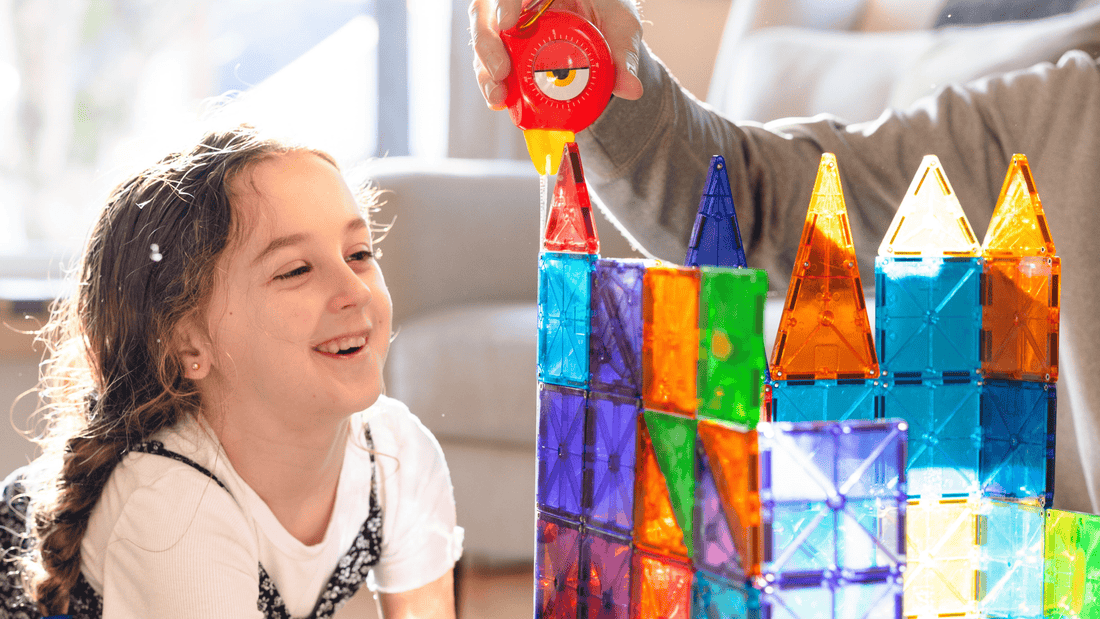
The ABC's of STEM: How Measuring Introduces Math Concepts
Have you ever considered how Handy Famm's 3-in-1 Tape Measure, Level, and Angle Finder can introduce your child to the intriguing world of mathematics? Let's take a trip through the fundamentals of STEM, where we learn that measuring is not just about inches and centimeters - it's an interactive adventure that introduces basic mathematical concepts!
A is for Awareness- Measuring encourages awareness of numerical relationships. When children measure the length of a craft stick or the width of a book, they begin to understand numerical concepts in a tangible way.
B is for Basic Operations- Our tape measure makes addition and subtraction a breeze! By measuring and comparing lengths, kids engage in basic operations, improving their arithmetic skills.
C is for Comparison- Measuring involves constant comparison. Comparing the height of a Lego block tower with that of a teddy bear helps children understand concepts like bigger, smaller, longer, and shorter.
D is for Dimension- Introducing the Third Dimension! Our angle finder encourages children to explore angles and spatial relationships, helping them understand geometry.
E is for Equations- Encouraging kids to explore simple equations as they measure and compare, fostering a playful introduction to basic mathematical expressions
F is for Future Skills- Early experiences with measuring lay the foundation for future STEM skills. As children grow, so does their ability to apply math in real-world scenarios.
G is for Gradation- As children measure and mark gradations, they develop an understanding of units and intervals. Gradations become a visual representation of quantity, setting the stage for more advanced math concepts.
H is for Hands-on Learning- Our 3-in-1 Tape Measure, Level, and Angle Finder turns abstract math into a hands-on experience. Children actively engage with measurements, making learning memorable and enjoyable.
I is for Integration- Measuring integrates various mathematical concepts. Length, width, and angles converge, producing a holistic approach to understanding math in different dimensions.
J is for Joining Forces- Measuring invites collaboration. Children can compare measurements with friends or work on family DIY projects, learning the value of teamwork and shared problem-solving.
K is for Kinesthetic Learning- The act of measuring involves physical movement, catering to kinesthetic learners. Hands-on measuring enhances comprehension and retention of math concepts.
L is for Logical Reasoning- Measuring fosters logical thinking. Children analyze data, make comparisons, and draw conclusions, developing critical thinking skills that are crucial for mathematical reasoning.
M is for Multiplication- Our tape measure becomes a tool for multiplication exploration. By measuring and replicating lengths, children grasp foundational concepts of multiplication.
N is for Numerical Representation- Measuring encourages keen observation. Children become adept at observing mathematical relationships, from noticing differences in lengths to identifying patterns.
P is for Precision- Precision in measurement is key! Our tools introduce the importance of accuracy, instilling habits that align with mathematical precision.
Q is for Quantitative Analysis- Measuring sets the stage for quantitative analysis. Children learn to interpret and analyze data, an essential skill in mathematical problem-solving.
R is for Ratio and Proportion- Exploring measurements introduces children to the concepts of ratio and proportion. They begin to understand relationships between different sizes and quantities.
S is for Symmetry- Measuring helps children encounter symmetry. They understand balance and harmonious proportions in various shapes.
T is for Time Management- Extend the learning to time! Introduce concepts of duration and intervals by measuring how long it takes to complete different activities.
U is for Understanding Units- Measuring familiarizes children with different units of measurement, like inches, centimeters, or degrees. They develop an understanding of units and their conversions.
V is for Visualization- Measuring aids in the visualization of abstract mathematical concepts. Children learn to picture measurements, making math more accessible and relatable.
W is for Weight and Mass- Expand the measuring experience to weight and mass. Children explore how different objects vary in weight, laying the groundwork for future science and math studies.
X is for eXploration- Measuring becomes an exploration of shapes and sizes. Children can measure the circumference of a jar or the height of a block tower, embarking on a journey of discovery and creativity.
Y is for Yielding Confidence- Through measuring, children gain confidence in handling numbers and quantities. It's a foundational step toward embracing more complex mathematical challenges.
Z is for Zest of Learning- Infuse learning with enthusiasm! Measuring ignites a zest for understanding, making math an exciting journey for young minds.
And there you have it - the complete ABCs of STEM with Handy Famm!


 https://handyfamm.com
https://handyfamm.com